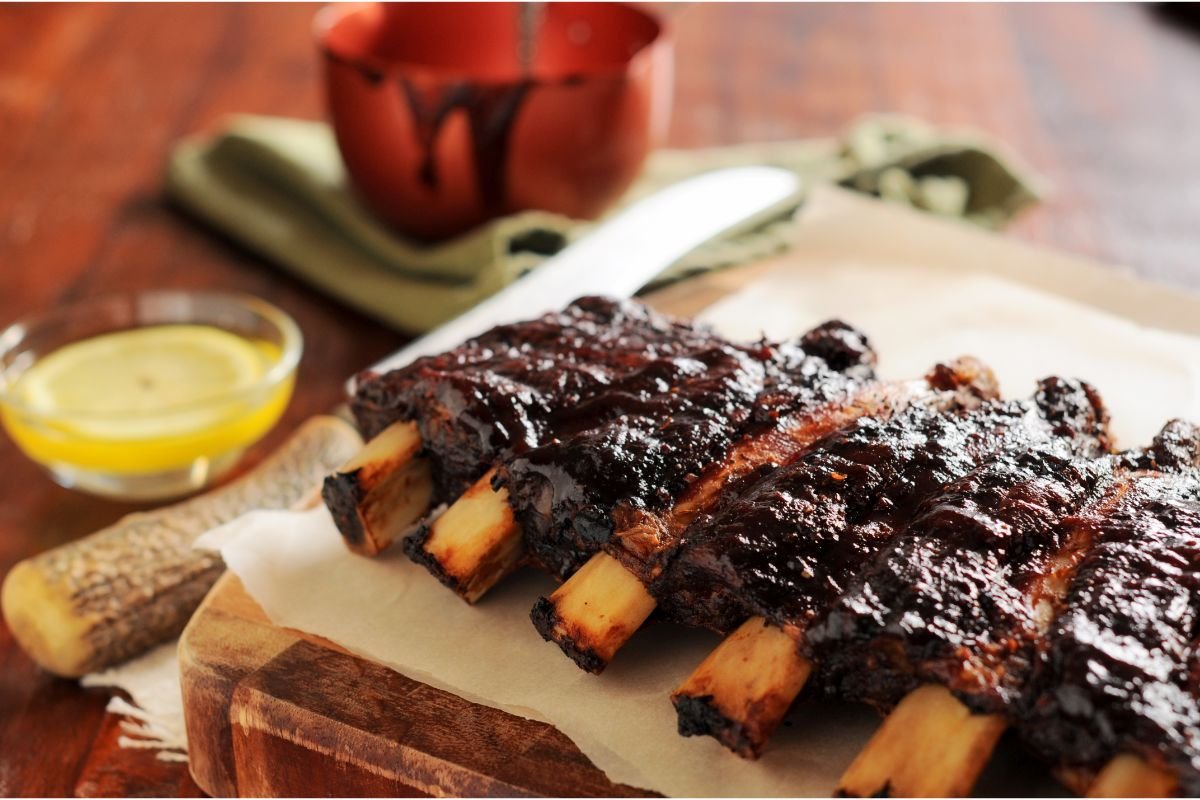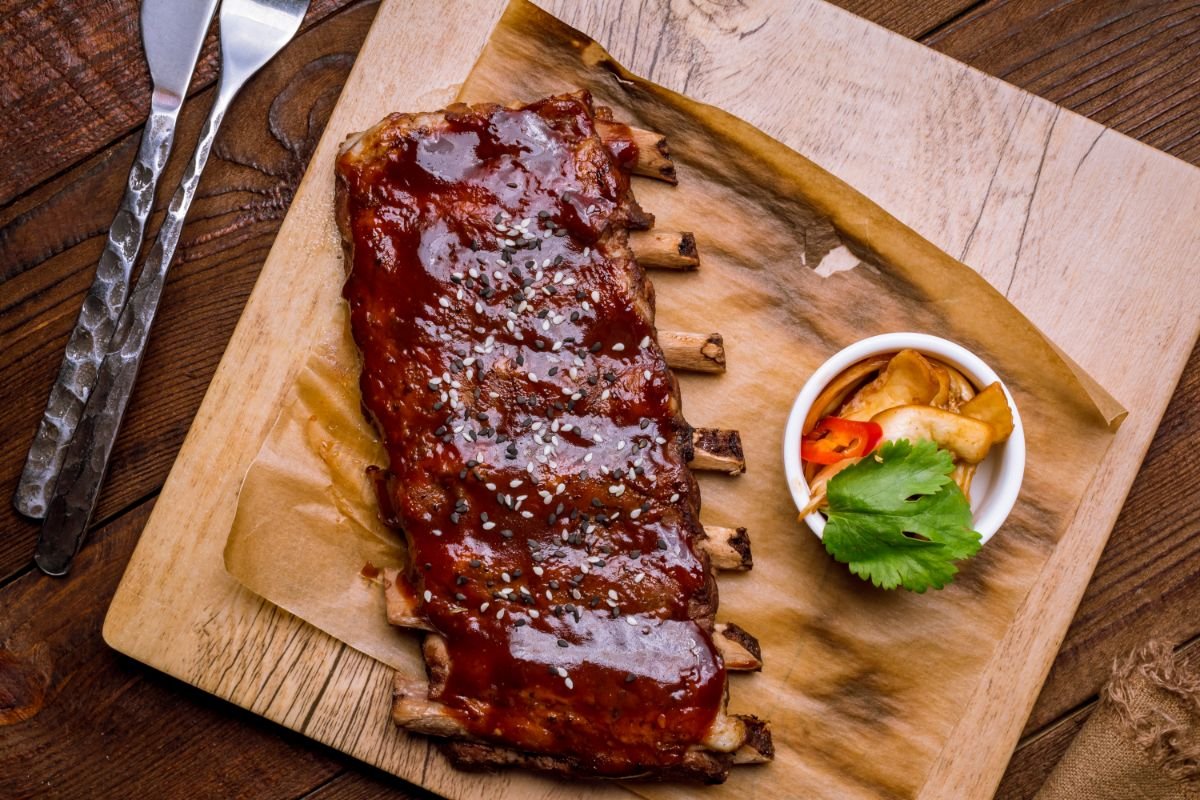A summer BBQ, family celebration or game day meal wouldn’t be complete without serving up some delicious ribs. What carnivore doesn’t love a rib?

The majority of the time when you hear ‘ribs’ you think of pork ribs. However, have you ever considered using beef ribs instead?
Using different cuts of meat can produce different flavors and taste sensations, which is exactly what happens when you choose a different type of meat.
Beef and pork ribs both taste great when cooked on the grill, but that doesn’t mean they’re the same.
They differ in terms of size, nutritional value and fat content. Preparation of the ribs can also play a huge part in how they taste. For example, people tend to add more seasoning to pork ribs as they have a more mild natural flavor.
Sometimes you get bored of cooking the same dishes for every event. If you’re looking to change up your rib routine, you need to find out which is best suited to you. Let’s compare the differences between beef and pork ribs.
Pork Ribs
We say ribs as an umbrella term as there are a few varieties depending on the cut of the meat. The cut can influence the texture and flavor of the meat.
Baby Back Ribs
These are taken from the upper loin area which is the upper rib cage, they are referred to as “baby” as they are smaller than other types of ribs.
The meat is lean and tender with less meat on them than others therefore they don’t take as long to cook.
Spare Ribs
Spare ribs are what you commonly find in a takeaway restaurant as they are the cheapest option.
These come from the sternum of the pig and contain the most meat and fat so are considered to have the most flavor. They lack the curve of the baby back ribs and are typically less tender.
St. Louis Ribs
St. Louis ribs are cut from the spare ribs and can be categorized as medium in size.
The difference between these and spare ribs is the way they are prepared; the rack has been trimmed down to remove cartilage and small bone fragments. The sides are squared off, producing a flat, rectangular-shaped piece of meat.
Rib Tips
No this isn’t a section on how to best cook the ribs. Rib tips refer to the pieces of meat that were cut from the end of the St. Louis style ribs.
These contain a lot of fat but are very tender, so they aren’t for everyone and shouldn’t be consumed too often due to the fat-to-meat ratio. If you don’t want to waste any part of the animal then cooking rib tips is a great waste-avoiding hack.
Beef Ribs
The less common BBQ food is beef rib. Although they are just as tasty, they can be a little more expensive which puts people off.
Back Ribs
Similarly to pork, beef back ribs are also taken from the upper section of the animal, just behind the shoulders consisting of the meat that’s left over once the ribeye is cut away. Less meat and flavor are found in these ribs making them leaner than other cuts.
Short Ribs
Cut from the lower portion of the animal’s rib cage, short plate ribs are packed full of meat and are incredibly tender when cooked.
These ribs are known for bursting with flavor. Their meaty content and size make them perfect if you’re cooking for large gatherings as two people can easily get an adequate portion from one bone.
Chuck Short Ribs
The chuck is a large primal cut of beef which is made up of the upper part of the ribs, the shoulder and the neck. These are classed as short ribs as the bones are smaller, yet they still have an impressive amount of meat on them.
Difference In Size
In terms of size, beef ribs are obviously bigger. When you picture a pig and a cow standing side-by-side, you can automatically tell they are always going to produce the biggest rib portions.
For reference, beef ribs are usually weighed in pounds and pork is usually weighed in ounces. However, beef ribs aren’t always bigger when you buy them.
When meat is sold and distributed, it wouldn’t make sense for huge ribs to be on grocery store shelves as they probably would take up too much room.
Buying a beef rib from a grocery store may be a little larger than the pork ribs, but this is really dependent on where you shop.
If you are unsure about which you’d like to serve at your BBQ it might be cost-effective to work out how many guests you’ll be feeding so you’ll need to buy less depending on where you source your meat.
Some butchers can reserve bigger ribs for customers who are making substantial purchases.
Note here that as beef ribs tend to be larger cuts of meat, they will often take longer to cook.
Difference In Flavor
This is probably the most subjective question you could ask. As we all have different preferences regarding taste, you could ask the whole BBQ party and they may all give you a different answer.
There are a variety of different types of rib amongst these two types of meat that relate to the part of the animal they’ve come from.
Typically, beef ribs tend to have a much stronger and more distinct taste compared to pork. A word often used to describe the flavor of beef is “umami”.
Unami is one of the five taste senses that can detect sweet, savory, salty, sour and bitter flavors. Hence why it is usually used to describe beef as savory; beef has many of the qualities and acids that make up the flavor profile.
Pork ribs on the other hand have a more mild taste which is why we tend to coat them in seasonings and slather them in sauces. Sometimes people even refer to pork ribs as sweet.
Flavors and texture can vary depending on the cut of the meat, but they all tend to be quite fatty. Spare ribs pick up a lot of flavor from the rendered fat, which could be considered the only exception to the general taste of pork ribs.
Difference In Fat Content
This is a general guide to the fat content of both beef and pork ribs as this can vary due to the breed, the individual animal and also how the butcher cuts the meat.
Pork Ribs
Pork ribs are known for being quite lean cuts of meat. The fat content increases the lower down on the rib cage you go with the tip of the rib being mostly fat with bone.

Spare ribs have the highest fat content amongst pork cuts so you may want to take extra precautions when preparing them to make sure it renders.
Beef Ribs
Contrary to what you may think, beef ribs tend to have more gelatinous fat and a relatively even proportion of meat to fat.
Although the bones are bigger, they tend to have more meat per bone compared to pork ribs, especially at the top of the bone.
Difference In Nutrition
As mentioned above, the fat content is much higher in beef ribs which adds to the number of calories. Consuming too much fat is bad for your health and has been linked to heart diseases and cancers.
That being said, beef ribs are higher in protein and iron compared to pork ribs. Although the calorie count is higher with beef ribs which essentially means you need to eat less of them.
Eating foods high in fat is fine in moderation as part of a healthy and balanced diet. If you are eating ribs a lot, choosing pork ribs is a healthier option.
Iron is an important vitamin which helps your body create red blood cells to carry oxygen around the body. If you’re lacking in iron you may feel fatigued which can lead to developing anaemia.
Difference In Price
Shopping on a budget can be tough but it doesn’t mean that you have to compromise on taste. Generally speaking, pork ribs are less expensive and offer much better value for money than beef ribs. Spare ribs tend to be the least expensive of all pork ribs.
If you’re opting for the more expensive option, you can still buy a cheaper cut of beef to save a little money. Short ribs are the most expensive cut of beef ribs as they are leaner and meatier.
Although back ribs have less meat on them, you’ll need more of them to get a good amount of meat which could end up costing you more money.
Grilling
Pork ribs can be cooked low and slow on the grill, roasted in the oven or by chucking in a slow-cooker. This will take between 1-2 hours.
Certain cuts of beef can be cooked similar to pork ribs such as beef back ribs, however, you shouldn’t cook short ribs in this way. Short ribs need to be cooked over low heat for a long time. For best results, try braising them.
Due to the flavors that naturally arise from the meat, there is also a difference in what you need to season the meat with. Beef ribs may just need a little salt and pepper whereas you may want to add a sticky BBQ sauce to pork ribs.
Smoking both types of ribs will draw out the most flavor.
Conclusion
No two types of meat are the same, beef and pork ribs differ in terms of size, meat content, nutritional value, flavor and more.
Knowing the differences between the two can help you become a master of the grill, particularly due to the different cooking times. Personal preference and budget will ultimately influence your decision when deciding which to grill.
We hope this has cleared up any confusion you had about the different kinds of ribs. Happy cooking!
